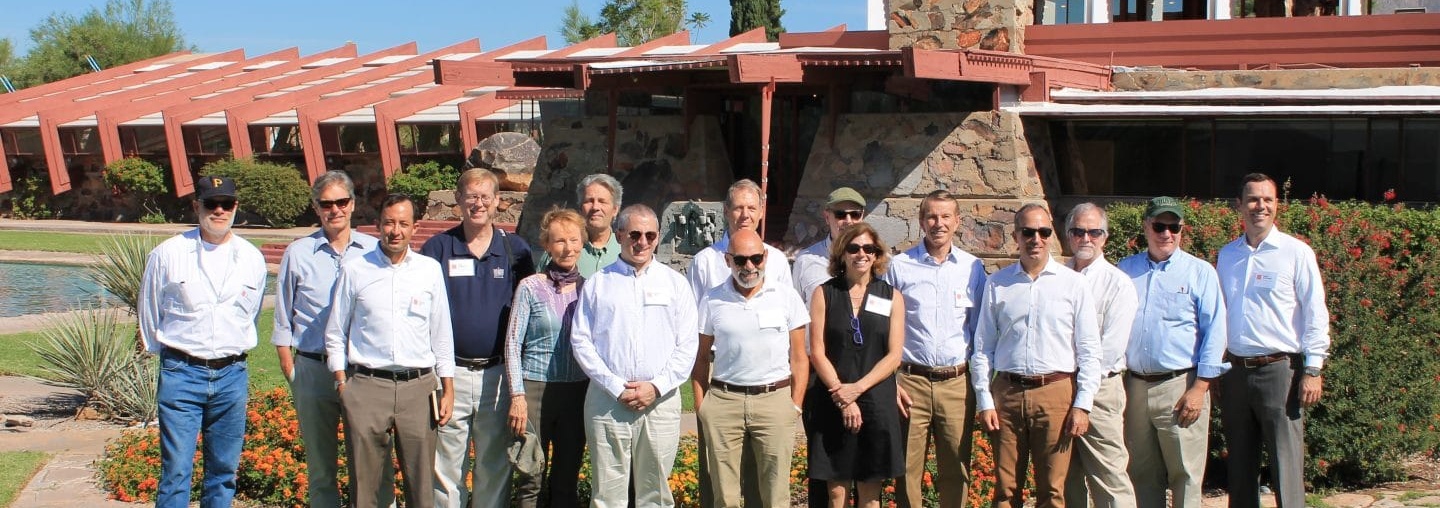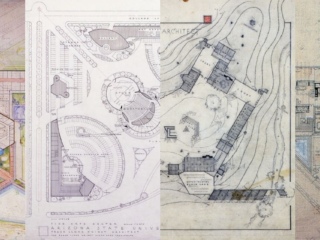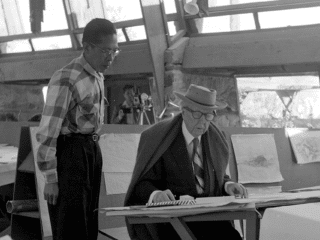
Taliesin West Hosts Summit of Historic Preservation Thought Leaders
Frank Lloyd Wright Foundation | Oct 31, 2016
Nearly 80 years after designing and building Taliesin West, Frank Lloyd Wright’s desert masterpiece faces constant and unique preservation challenges.
In October the Frank Lloyd Wright Foundation invited some of the nation’s leading experts in historic preservation to Taliesin West for a summit focused on values-based strategies for the restoration and conservation of the National Historic Landmark.
Taliesin West was Wright’s architectural laboratory from 1938 to 1959. It was used not only as a winter home for the Wrights and the Taliesin Fellowship, but also as a place of exploration and innovation that was under continuous development and never meant to be fixed in time or “finished.” The preservation workshop aimed to address the complicated conservation efforts at Taliesin West, not merely as a time capsule that reflects the aesthetic of the buildings in 1959, the year of Wright’s death, but as a living site that honors the spirit of innovation that continues to make Frank Lloyd Wright relevant now and into the future.
The summit was led by the Frank Lloyd Wright Foundation’s Stuart Graff, President & CEO, and Fred Prozzillo, Director of Preservation, along with renowned preservation architect, Gunny Harboe, who shared the Preservation Master Plan (PMP) he developed for Taliesin West in 2015. Graff challenged the group to look at both Taliesin West as a whole and the individual structures at the site more closely to help explore what parts of Wright’s legacy they help us reveal.
Ralph L. Keeney, Professor Emeritus of Decision Sciences at Duke University, and Patrick S. Noonan, Professor in Practice Emeritus at Emory University, led the summit attendees in an insightful discussion on Decision Analytics, which Noonan explained, “provides a variety of practical tools for enhancing any organization’s decision quality.” The pair also introduced the concept of values-focused thinking, which Keeney related to the discussion as it “helps those concerned about preservation express their objectives for it, which is relevant for decisions at Taliesin West, as well as to any other significant historical preservation decisions.”
Attendees then had a spirited conversation about how to take a values-based approach to preservation that encourages telling the story of Taliesin West across several time periods, and not just at a single moment in Wright’s career. Embracing not only his history, but also that of the Taliesin Fellowship, will give a more complete view of Wright’s legacy. John Stubbs, Director of the Master of Preservation Studies program at Tulane University, agreed that any implementation of the PMP should not default to removing buildings created after Wright’s death “without serious consideration of a variety of important additional values associated with the place.”
While the discussion focused on efforts to be undertaken at Taliesin West, the attendees expressed hope that this work will ultimately benefit the field as a whole. Chandler McCoy, Senior Project Specialist at the Getty Institute expressed, “Taliesin West is an iconic place that can be a leader in demonstrating sound preservation planning and practice. It still has a lot to teach about desert living, sustainability, and architectural conservation.” Ashley Wilson, Graham Gund Architect at the National Trust for Historic Preservation, sees a leadership role for the Frank Lloyd Wright Foundation in driving a values-based approach to preservation. “Taliesin West, by being true to its roots, will provide a great example of the flexibility of modern preservation,” she stated.
“And that is the trick—each site makes the best decisions they can that align with the ethos of the place.”
Jim Erickson, Director of Preservation at Taliesin in Wisconsin, also participated in the workshop. “We will be applying a values-based approach to our future conservation efforts at Taliesin,” said Erickson, “so that the two sites together offer a more complete view of the work of the Wrights and their followers.”
The Foundation is extremely grateful for the support and guidance of an incredible panel of experts in the field. As the staff reflects on the summit and begins to determine how to best allocate resources to begin this work that will shape how visitors view Taliesin West, Taliesin, and Frank Lloyd Wright’s legacy, Graff is excited about the future. “I hope that the exploration of values-based decision-making will aid the adoption of values-based conservation principles, and that the work done at the Foundation will provide a useful example for the field.”
This article originally appeared in the Fall 2016 issue of the Frank Lloyd Wright Quarterly, “And Thou America: On Wright’s Democratic Ideals.”



